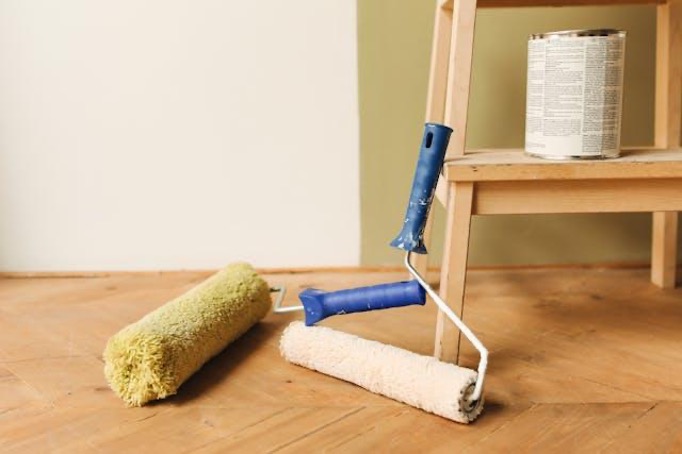

By Ella Shauman
For college students living off campus, the end of a lease can be as exciting as it is anxiety-inducing. Landlords are notorious for being nitpicky during move-out inspections, with minor damage sometimes resulting in hefty deductions.
For students who haven’t waved goodbye to their security deposits thanks to interior decorating TikToks, below are some simple (and cheap!) repairs you can do yourself to help you get that full deposit back.

1. Patch Nail Holes in the Walls
Most landlords expect walls to be returned in pristine condition—no posters, tapestries, or photo collages left behind. If you’ve used nails or tacks, you’ll likely have small holes scattered across your walls. Thankfully, fixing them is easy:
What you need:
● Spackling paste or wall putty (around $5)
● Putty knife or even an old credit card
● Fine-grit sandpaper
● Matching wall paint (or ask your landlord for the brand and color)
How to fix:
Fill each hole with spackle using the putty knife, smooth it out, let it dry, then sand it lightly. Afterward, paint over the patched area. For small touch-ups, a paint sample or even a white toothpaste trick (for white walls only) can sometimes do the trick in a pinch.
2. Remove Scuff Marks and Stains
Walls, baseboards, and doors tend to collect black marks, scratches, and grime—especially in high-traffic areas. Before assuming it’s permanent damage, try this simple cleaning method.
What you need:
● Magic Erasers (or generic melamine foam sponges)
● Dish soap and warm water
How to fix:
Dampen the Magic Eraser and gently scrub scuffed areas. Most marks come off surprisingly easily without damaging the paint. Just be cautious with painted walls—scrubbing too hard can sometimes take paint off, too.
3. Deep-Clean Appliances
If your lease included appliances like a refrigerator, oven, or microwave, your landlord will expect them to be spotless. Don’t let a dirty fridge cost you $50 or more.
What you need:
● Baking soda, vinegar, and lemon (for natural cleaning)
● Scrubbing brush or sponge
● An old toothbrush for crevices
How to fix:
Empty and unplug your fridge, then clean all interior shelves and drawers with a baking soda and water paste. Use vinegar or lemon juice to deodorize. Don’t forget to clean behind and under the appliances and remove burnt-on food from ovens using oven cleaner or a vinegar-baking soda paste.
4. Fix Loose Screws and Handles
Cabinet doors falling off? Drawer handles loose? These are small issues that can make your place look more damaged than it actually is.
What you need:
● Screwdriver
● Wood glue (optional)
How to fix:
Tighten any loose screws on cabinets, drawers, and doors. If a screw hole is stripped, use a toothpick with wood glue to fill it, let it dry, and then reinsert the screw.
5. Replace Burnt-Out Light Bulbs
It seems silly, but some landlords will deduct from your deposit for every missing or burnt-out bulb. Don’t give them the opportunity!
What you need:
● Light bulbs (check fixture type—LED, incandescent, wattage, etc.)
● Step stool
How to fix:
Do a sweep through your place before moving out and replace all non-working bulbs. Also, check smoke detectors—they often share responsibility with tenants.
6. Unclog Drains and Deodorize Sinks
Slow drains or heart-stopping sink odors can be an easy excuse for maintenance deductions.
What you need:
● Baking soda and vinegar
● Drain snake or wire hanger
● Plunger
How to fix:
For unpleasant scents, pour a cup of baking soda followed by a cup of vinegar down the drain, wait 10 minutes, then flush with hot water. For clogs, use a drain snake to pull out hair or debris. If you suspect a deeper clog, a plunger can also help clear it.
7. Touch Up Paint or Get Creative with Damage
Major wall damage like chips, dents, or peeled paint can be intimidating, but not impossible to fix.
What you need:
● Touch-up paint
● Wall repair kits (available at hardware stores)
● Creative solutions (like strategically placed art or furniture during inspection—just be honest if asked)
How to fix:
For small chips or scrapes, sand the area smooth and paint over it. For larger dents, a patch kit with mesh and joint compound will do the trick. If you don’t have paint, some hardware stores will color-match it for you if you bring in a chip.
8. Clean Floors and Carpets Thoroughly
Dust, crumbs, and stains build up over time, especially in shared housing. A good floor cleaning can make a world of difference.
What you need:
● Vacuum and mop
● Carpet cleaner or spot remover
● Baking soda
How to fix:
Vacuum all carpeted areas and mop hard floors. Use a carpet stain remover on any spills or marks, or sprinkle baking soda on the carpet to absorb odor, then vacuum again.
Final Tips Before You Move Out:
● Take Photos: After you clean and make repairs, take timestamped photos of every room for proof of condition.
● Communicate with Your Landlord: Ask for a pre-move-out inspection if possible and get a checklist of expectations.
● Document Repairs: Keep receipts and take before-and-after photos if you make notable repairs.
Getting your full security deposit back isn’t just about avoiding damage—it’s about showing your landlord you cared for the space. A weekend of light maintenance can pay off in the form of hundreds of dollars returned to your bank account—and leave you with peace of mind as you transition to your next space.



 Equal Housing Opportunity
Equal Housing Opportunity

